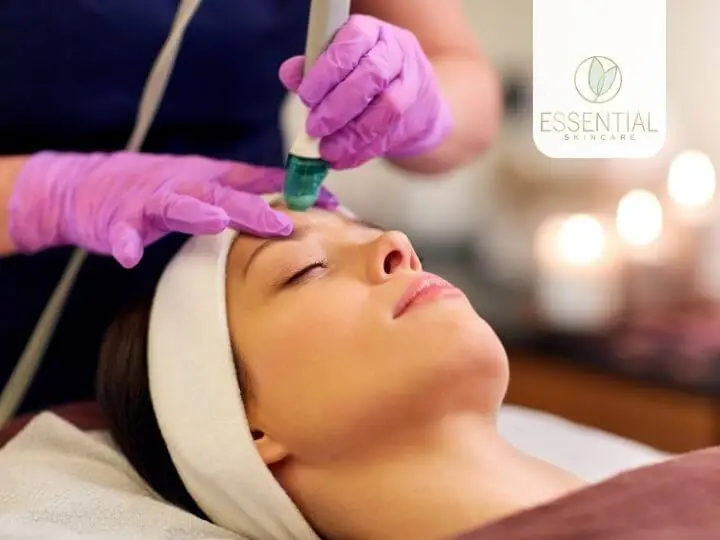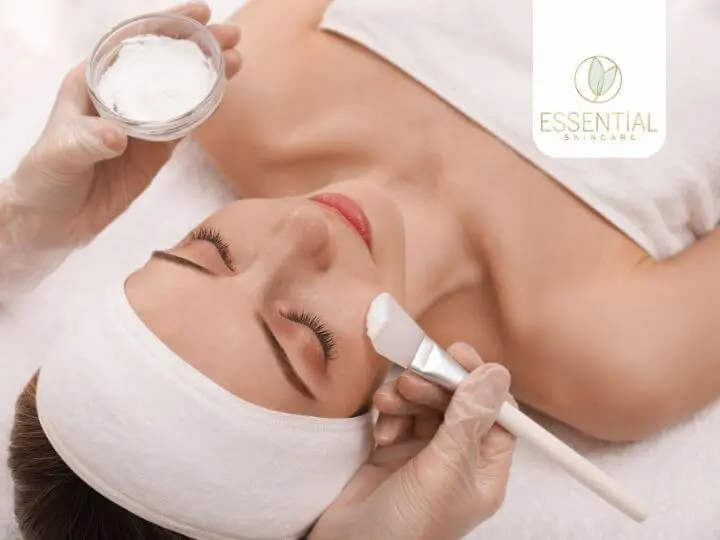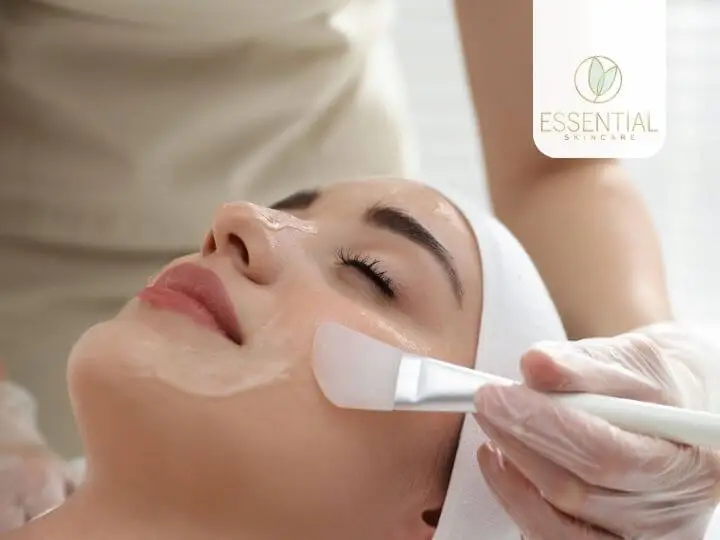Chemical peels are a popular skincare treatment offered by Essential Skincare that can significantly improve the elasticity of your skin. This article will delve into the science behind chemical peels, their impact on skin elasticity, and the potential benefits and risks associated with this treatment. Whether you’re considering a chemical peel or simply curious about the process, this comprehensive guide will provide you with the information you need to make informed decisions about your skincare regimen.
Understanding Chemical Peels
In the realm of skincare, chemical peels have carved a niche for themselves, gaining popularity for their multifaceted benefits and potential for dramatic improvements. These treatments offer a novel way to enhance skin aesthetics, tackling a range of issues from fine lines and wrinkles to uneven pigmentation and acne. However, before opting for this procedure, it’s essential to comprehend what chemical peels entail, their various types, and the process involved. In this segment, we’ll journey into the fascinating world of chemical peels, shedding light on their core principles, the diverse options available, and the steps involved in this transformative skincare procedure.
What are Chemical Peels?
At their core, chemical peels are a form of cosmetic procedure that involves applying a specially formulated chemical solution to the skin. This solution instigates the exfoliation of the outermost skin layers, which subsequently peel off, unveiling a fresher, smoother layer underneath. The extent of peeling can be tailored to individual needs, depending on the type of peel chosen.
There are three primary categories of peels – light, medium, and deep. These classifications are based on the potency of the chemicals used and the depth of skin exfoliation they induce. Each type is designed to address specific skin issues. Whether incorporated into a comprehensive skincare routine or used as a standalone treatment, chemical peels can significantly enhance skin tone, texture, and elasticity, diminish signs of aging, and boost overall complexion.
Administered by a skilled skincare professional in a controlled environment, chemical peels are designed to be both safe and effective. The end result? Skin that is revitalized, refreshed, and radiates a youthful glow.
Types and Functions of Chemical Peels
Chemical peels can be categorized into three primary types: light, medium, and deep. Each type varies in the chemical composition, concentration, depth of skin penetration, and overall impact on the skin.
- Light peels: Often referred to as superficial or lunchtime peels, these are the gentlest form of chemical peels. They utilize alpha and beta hydroxy acids like glycolic acid, salicylic acid, and lactic acid. These peels focus on the skin’s outer layer, the epidermis, providing a gentle exfoliation that enhances skin tone, texture, and reduces minor discoloration, acne, dryness, and fine lines.
- Medium peels: These peels delve deeper, targeting both the epidermis and the upper section of the dermis, the skin’s middle layer. Trichloroacetic acid (TCA) is the common chemical used in medium peels. These peels are more potent in correcting moderate skin discoloration, deeper wrinkles, and acne scars.
- Deep peels: As the name suggests, deep peels penetrate the furthest into the dermis, offering the most dramatic and enduring results. Phenol is the typical chemical used in these peels. Deep peels are effective in treating severe wrinkles, sun damage, deeper scars, and precancerous growths. However, they also come with longer recovery periods and increased risk of complications.
Remember, the selection of a chemical peel should be based on your specific skin issues, skin type, desired outcomes, and your ability to accommodate recovery time. Always seek advice from a skincare professional before deciding on a chemical peel treatment.
The Chemical Peel Process
The journey to a chemical peel begins with an initial consultation. During this meeting, a skincare professional will assess your skin, discuss your concerns, and suggest the most appropriate peel type. This consultation also serves to educate the client about the procedure, expected results, and potential risks.
- Pre-peel phase: This preparatory step is crucial, particularly for medium to deep peels or for individuals with specific skin types. During this phase, clients may be asked to use certain products to enhance peel results and reduce potential risks. The preparation period can last from a week to two, depending on the skin type and intensity of the peel.
- Peel application: On the treatment day, the skin is thoroughly cleansed, and the selected peel solution is applied to the face, and occasionally, the neck and hands. A burning or tingling sensation during application is normal.
- Neutralization and removal: Light peels naturally neutralize and do not require removal, while medium to deep peels may need a neutralizing solution before being washed off.
- Post-peel treatment: After the peel, your skincare professional may apply a soothing mask, serums, or creams to calm the skin. For deeper peels, dressings may be applied to the treated areas.
- Recovery: Post-peel, the skin may look red and feel tight. Light peels may cause mild flaking, but normal activities can usually be resumed immediately. Medium and deep peels may lead to swelling, blistering, or peeling skin that requires several days or weeks to heal.
It’s important to remember that a chemical peel is a medical procedure. It should be performed by a licensed professional to ensure safety and effectiveness.
How Chemical Peels Enhance Skin Elasticity
The journey towards maintaining skin health is multifaceted, with skin elasticity being a key component that often takes center stage as we age. Elasticity refers to the skin’s capacity to return to its original form after being stretched. As we grow older, this ability diminishes, leading to sagging skin and the emergence of wrinkles. In this segment, we delve into the role of chemical peels in counteracting this natural aging process, enhancing skin elasticity, and promoting a more youthful appearance.
Chemical Peels and Skin Elasticity
The influence of chemical peels on skin elasticity is profound, primarily due to their ability to stimulate a process of regeneration and remodeling within the skin’s layers.
Imagine applying a peel solution as setting off a controlled, beneficial chain reaction in your skin. This solution causes a selective injury to the skin, effectively removing the damaged outer layers. This controlled damage incites a healing response from the skin, setting off a series of events at the cellular level. Skin cells rally to repair the damage, leading to the production and reorganization of collagen and elastin fibers – the two primary proteins that give skin its firmness and elasticity.
The outcome? A remodeling of the skin that results in a firmer, more resilient surface with enhanced elasticity. Additionally, the removal of the damaged skin paves the way for new, fresh skin with an improved texture and appearance.
It’s worth noting that the enhancement in skin elasticity is typically more pronounced with medium to deep peels, due to their ability to penetrate the deeper dermal layer where collagen and elastin are located. This is why a series of light peels or a single medium to deep peel can result in noticeable reductions in fine lines and wrinkles, a clear indication of improved skin elasticity.
Scientific Mechanisms Behind Improved Elasticity
Delving into the science behind chemical peels, we find a fascinating sequence of events that lead to improved skin elasticity. This process can be divided into several key stages.
Firstly, we have Exfoliation. This is the immediate response to a chemical peel, where the stratum corneum, or the skin’s outermost layer, undergoes rapid exfoliation. This phase involves shedding off dead and damaged cells, revealing the fresher, more vibrant skin underneath.
Next, we move to Epidermal Stimulation. This stage involves the activation of the epidermis, the skin’s top layer. Chemical peels trigger the growth of new epidermal cells, known as keratinocytes. As these cells rise to the surface, they give the skin a healthier and more radiant appearance.
The third stage, Dermal Remodeling, is perhaps the most crucial for enhancing elasticity. This phase occurs in the dermis, the skin’s second layer. The skin responds to the peel-induced injury by producing growth factors that stimulate fibroblasts, the cells responsible for collagen and elastin production. This surge in production results in a thicker, more resilient dermis, thereby boosting overall skin elasticity.
Lastly, we have Increased Hyaluronic Acid Production. Certain peels, particularly those containing alpha hydroxy acids (AHAs), encourage the skin to produce more hyaluronic acid. This molecule is essential for maintaining skin hydration and fullness, both of which are critical for supporting skin elasticity.
In essence, chemical peels trigger a complex series of scientific reactions that not only enhance skin elasticity but also improve overall skin quality and appearance.
Evaluating the Benefits and Risks of Chemical Peels
As with any skincare procedure, it’s crucial to weigh the benefits against potential risks when considering chemical peels. This understanding enables you to make informed decisions and set realistic expectations about this transformative treatment.
In this section, we’ll explore the advantages of chemical peels and discuss potential side effects. Our goal is to provide you with comprehensive information, ensuring you’re well-equipped to make an informed decision about this skin-rejuvenating treatment.
Advantages of Chemical Peels
Chemical peels have earned their stripes in the realm of skincare, providing a wealth of advantages that go beyond enhancing skin elasticity. Let’s delve into the myriad of benefits that these treatments offer:
- Enhanced Skin Texture and Tone: Chemical peels work wonders in refining the skin’s texture and evening out its tone. By promoting the shedding of dead skin cells and impurities, they pave the way for a smoother, more balanced complexion.
- Skin Revitalization: These treatments stimulate the production of fresh skin cells, leading to a more youthful and rejuvenated appearance.
- Anti-Aging Effects: By boosting collagen and elastin production, chemical peels help to diminish fine lines, wrinkles, and sagging skin, offering a natural anti-aging solution.
- Acne Management: Certain chemical peels are particularly effective in addressing acne and acne scars, reducing inflammation and clearing clogged pores.
- Improved Efficacy of Skincare Products: By stripping away the outer layer of dead skin, chemical peels enhance the skin’s permeability, allowing skincare products to penetrate more deeply and work more effectively.
- Brighter Complexion: Through the dual action of exfoliation and cell regeneration, chemical peels promote a brighter, more luminous complexion.
- Non-Invasive: Despite their significant impact, chemical peels are non-invasive treatments that deliver substantial results.
Collectively, these benefits enable chemical peels to dramatically improve the overall health and aesthetic of the skin.
Potential Risks and Side Effects
While chemical peels are generally considered safe, they do carry some potential risks and side effects. Being aware of these is essential for making an informed decision about undergoing this treatment. Here are some potential drawbacks to consider:
- Skin Redness: Post-treatment, you may experience some redness akin to a mild sunburn. This typically fades within a week, although it may persist longer following more intensive peels.
- Discomfort and Irritation: You may feel mild discomfort, itching, or a stinging sensation immediately after the procedure. These symptoms are temporary and usually subside as your skin starts to heal.
- Peeling and Flaking: As the name suggests, peeling and flaking of the skin is a common side effect as the old, damaged skin sheds to reveal the fresh layer beneath.
- Changes in Skin Color: Chemical peels can occasionally cause hyperpigmentation (darkening of the skin) or hypopigmentation (lightening of the skin). These effects are more prevalent in individuals with darker skin tones.
- Scarring: Although uncommon, chemical peels can cause scarring, particularly with deeper peels. This is more likely if you have a history of keloids or abnormal wound healing.
- Infections: While extremely rare, there is a slight risk of bacterial, fungal, or viral infections following a chemical peel.
To mitigate these risks, it’s crucial to consult with a skincare professional who can evaluate your skin’s suitability for the treatment, choose the right type and strength of peel, and provide aftercare instructions. Always disclose your full medical and skin history to your skincare professional, and adhere strictly to post-care guidelines to ensure optimal healing and minimize potential risks.
Optimizing Post-Treatment Care and Results
To truly reap the rewards of your chemical peel, it’s crucial to adopt a specialized skincare regimen and make certain lifestyle adjustments after the procedure. This section aims to equip you with the knowledge needed to maintain and even enhance the results of your chemical peel. Our goal is to empower you to extract the utmost value from this transformative skin treatment.
Effective Post-Peel Skin Care
Post-procedure skin care is a critical component in achieving the best possible outcomes from your chemical peel, while also mitigating potential side effects. Here are some key steps to follow:
- Sun Protection: Post-peel skin is particularly vulnerable to sun damage. Shield your skin with a minimum SPF30 sunscreen and consider wearing a wide-brimmed hat when exposed to the sun.
- Hydration: Regular application of a hypoallergenic, fragrance-free moisturizer can soothe your skin and expedite the healing process.
- Resist the Urge to Pick: Peeling or flaking skin is a common occurrence after a chemical peel. Despite the temptation, refrain from pulling or scratching at the skin to prevent scarring and further damage.
- Gentle Skincare Products: For at least a week after your peel, steer clear of abrasive skincare products, including retinoids, exfoliants, and those containing alcohol.
- Healthy Lifestyle: Proper hydration and nutrition are instrumental in skin recovery. Ensure you’re drinking ample water and consuming a balanced diet rich in fruits, vegetables, and lean proteins.
- Avoid Heat-Inducing Activities: Postpone any strenuous exercise or activities that generate heat for at least 48 hours after your peel. Sweat can irritate the skin and hinder the healing process.
Remember, everyone’s skin responds differently to treatment. For optimal results, adhere to the specific aftercare instructions provided by your skincare professional.
Prolonging the Results of Your Chemical Peel
A chemical peel can work wonders for your skin, but the key to maintaining these benefits lies in your post-treatment care. Here are some strategies to help you extend the positive effects of your chemical peel:
- Establish a Skincare Regimen: A consistent skincare routine is vital. Incorporate products such as serums, moisturizers, and sunscreens to shield your skin from sun damage. This routine will help preserve the health of the fresh skin cells unveiled by the peel, thereby delaying the aging process.
- Hydrate and Nourish: As previously discussed, keeping your body hydrated and following a diet rich in vitamins, particularly vitamin C and E, can enhance skin health and prolong the results of the peel.
- Regular Use of Retinoids: Retinoids, which are derived from vitamin A, promote cell renewal and stimulate collagen production, thereby maintaining the skin’s thickness and elasticity. However, it is crucial to consult your skincare professional before adding retinoids to your routine, especially after a peel.
- Schedule Follow-Up Treatments: Depending on your specific skincare needs and objectives, scheduling regular maintenance peels can play a significant role in extending the benefits of your initial treatment.
- Minimize Sun Exposure: It’s not just crucial immediately post-peel, but limiting sun exposure in the long term can prevent premature aging, hyperpigmentation, and skin cancer, thereby extending the lifespan of your peel’s benefits.
- Embrace a Healthy Lifestyle: Avoid habits like smoking and excessive alcohol consumption as they can rob your skin of vital nutrients and accelerate aging.
By adopting these practices, you can maximize the longevity of your chemical peel’s benefits. Remember, these tips should be supplemented with personalized advice from your skincare professional.
1. How do chemical peels affect skin elasticity?
Chemical peels encourage a process of rapid skin turnover, effectively eliminating older, less elastic skin layers, resulting in improved skin tone and elasticity as fresher, younger skin surfaces (Gordon, 2016).
2. What types of chemical peels impact skin elasticity significantly?
Medium to deep chemical peels, particularly trichloroacetic acid peels and phenol peels, significantly improve skin elasticity by triggering enhanced collagen production (O’Connor, Munavalli, & Alam, 2018).
3. Can chemical peels harm skin elasticity?
Unplanned or improperly administered chemical peels can potentially harm skin elasticity, causing scarring that may lead to skin rigidity. However, under professional supervision, such risk is minimal (O’Connor et al., 2018).
4. Are the effects of chemical peels on skin elasticity permanent?
Chemical peels boost skin elasticity momentarily. However, natural aging and environmental factors will cause the skin to lose elasticity over time. Regular treatments can maintain the improved elasticity (Gordon, 2016).
5. How long does it take to see improvements in skin elasticity following a chemical peel?
Visible improvements in skin elasticity after a chemical peel treatment typically appears between 1-2 weeks, coinciding with the healing process and the emergence of new skin cells (O’Connor et al., 2018).
6. For whom are chemical peels most impactful in terms of improving skin elasticity?
Chemical peels are most impactful for individuals with sun-damaged skin, aging skin, uneven pigmentation or fine lines. However, personal consultation is crucial to ascertain the degree of improvement in skin elasticity one may experience (Gordon, 2016).
References
Gordon, S. R. (2016). Chemical peeling: procedures in cosmetic dermatology (4th Ed.). Elsevier Health Sciences.
O’Connor, A. A., Munavalli, G. S., & Alam, M. (2018). Aesthetic dermatology: fundamentals and procedural knowledge. Springer Publishing.










